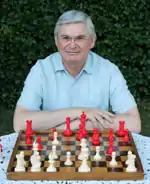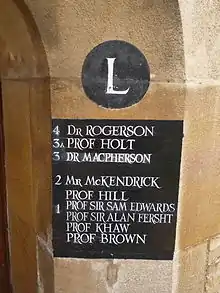Alan Fersht
Sir Alan Roy Fersht FRS FMedSci[6] (born 21 April 1943) is a British chemist at the Laboratory of Molecular Biology and an Emeritus Professor in the Department of Chemistry at the University of Cambridge;[7] and is a former Master of Gonville and Caius College, Cambridge.[8][9][10][11][12][13][14] He works on protein folding.[15][16][17][18][19][20][21][22]
Sir Alan Fersht | |
|---|---|
 | |
| Born | Alan Roy Fersht 21 April 1943 London, England |
| Alma mater | Gonville and Caius College, Cambridge |
| Known for | Protein folding |
| Spouse(s) | Marilyn Persell (m. 1966) |
| Awards |
|
| Scientific career | |
| Fields | |
| Institutions | |
| Thesis | Intramolecular Catalysis of Ester Hydrolysis (1968) |
| Doctoral students | |
Early life and education
Fersht was born on 21 April 1943[23] in Hackney, London. He was educated at Sir George Monoux Grammar School, an all-boys grammar school in Walthamstow, London.[23] He went on to study at Gonville and Caius College, Cambridge, where he was awarded his PhD degree in 1968.[24]
Career and research
Fersht spent a post-doctoral year (1968-1969) at Brandeis University working under William Jencks. He returned to Cambridge in 1969 as a group leader at the Laboratory of Molecular Biology until 1977 and a Junior Research Fellow at Jesus College, Cambridge until 1972. Fersht was Wolfson Research Professor of the Royal Society and Professor of Biological Chemistry at Imperial College London from 1978 to 1988. He spent a sabbatical year at Stanford University on an Eleanor Roosevelt Fellowship of the American Cancer Society with Arthur Kornberg (1978-9). Fersht was Herchel Smith Professor of Organic Chemistry at Cambridge from 1988 to 2010. He was the Director of the Cambridge Centre for Protein Engineering from 1990 to 2010 when, on reaching the retirement age, he became an Emeritus Group Leader at the Laboratory of Molecular Biology. He is a Fellow of both Gonville & Caius College and Imperial College.[18]
Alan Fersht is widely regarded as one of the main pioneers of protein engineering, which he developed as a primary method for analysis of the structure, activity and folding of proteins. He has developed methods for the resolution of protein folding in the sub-millisecond time-scale and has pioneered the method of phi value analysis for studying the folding transition states of proteins. His interests also include protein misfolding, disease and cancer.[1]
Selected publications
Awards and honours


Fersht was elected a Fellow of the Royal Society (FRS) in 1983.[27] The Royal Society awarded him the Gabor Medal in 1991 for molecular biology, in 1998 the Davy Medal for chemistry and in 2008 the Royal Medal. He is a Foreign Associate of the United States National Academy of Sciences,[28] a Foreign Member of the American Philosophical Society, a Foreign Member of the Accademia dei Lincei, an Honorary Foreign Member of the American Academy of Arts and Sciences and a Fellow of the Academy of Medical Sciences (FMedSci).[6] His nomination for the Royal Society reads:
Distinguished for work on mechanisms of enzyme catalysis, especially by stopped and quenched flow methods. He showed that a slow relaxation of chymotrypsin was not a chemical step on the reaction pathway, but a pH-dependent isomerisation between active and inactive forms, and investigated the energetics and equilibria of the transition. He elucidated the leaving-group specificity, leading to a detailed structural interpretation which showed the energetics of "strain" at the binding site. Another experiment dispelled final doubts about the role of a tetrahedral intermediate. More recently Fersht has studied a more complex group of enzymes, the aminoacyl tRNA synthetases. He demonstrated that their precise specificity depends on consecutive independent recognition steps, and under appropriate conditions he trapped a transiently discharged aminoacyl tRNA. Fersht has shown how binding energy can be used to enhance either specificity or rate in an enzymatic reaction, leading to a demonstration of thermodynamic limitations on mechanisms of the "induced fit" type.[27]
Fersht holds honorary doctorates from Uppsala University (1999),[29] Vrije Universiteit Brussel (1999), Weizmann Institute of Science (2004), Hebrew University of Jerusalem (2006), and Aarhus University (2008). He is an Honorary Fellow of Darwin College, Cambridge (2014) and Jesus College, Cambridge (2017). [23]
Fersht has received many prizes and medals including: the FEBS Anniversary Prize; Novo Biotechnology Award; Charmian Medal of the Royal Society of Chemistry; Max Tishler Lecture and Prize Harvard University; The Datta Lectureship and Medal of the Federation of European Biochemical Societies; Jubilee Lecture and the Harden Medal of the Biochemical Society; Feldberg Foundation Prize, Distinguished Service Award, Miami Nature Biotechnology Winter Symposium; Christian B. Anfinsen Award of the Protein Society; Natural Products Award of the Royal Society of Chemistry, Stein and Moore Award of the Protein Society;[30][31] Bader Award of the American Chemical Society; Kaj Ulrik Linderstrøm-Lang Prize and Medal; Bijvoet Medal of the Bijvoet Center for Biomolecular Research of Utrecht University in 2008 and the Gilbert N. Lewis Medal University of California, Berkeley, and the Wilhelm Exner Medal in 2009.[32]
In 2003 he was knighted for his pioneering work on protein science.[23] His citation on election to the Academy of Medical Sciences reads:
Herchel Smith Professor of Organic Chemistry at the MRC Centre for Protein Engineering, Cambridge, Sir Alan is one of the world's leading protein scientists. He was elected to the Royal Society in his late 30s in 1983 for his work illuminating enzymic catalysis and how enzymes attain high fidelity in the translation of the genetic code. Subsequently he was one of the pioneering founders of protein engineering, developing it as an analytical procedure for understanding interactions in proteins and enzyme catalysis. This radical new approach unravelled the relationships between the structure, activity and function of proteins. The full power of his methods became apparent in his seminal and far reaching contributions to the field of protein folding and stability. These studies opened the way to development of novel therapies in cancer and other diseases. He currently works on mutations that affect the stability and activity of the tumour suppressor p53 and how mutants may be "rescued" by small molecule drugs. His contributions have been widely recognised nationally and internationally by prizes for both chemistry and molecular biology, and by memberships of foreign academies.[6]
In August 2020 he was awarded the Copley Medal of The Royal Society, for his development and application of methods of protein engineering to provide descriptions of protein folding pathways at atomic resolution.[33]
Personal life
Fersht's recreations include chess,[34] horology and wildlife photography.[23] He married Marilyn Persell in 1966 and has one son and one daughter.[23]
References
- Alan Fersht publications indexed by Google Scholar
- Alan Fersht LMB Profile
- Clarke, Jane (1993). Studies of disulphide mutants of barnase. jisc.ac.uk (PhD thesis). University of Cambridge. OCLC 53666398. EThOS uk.bl.ethos.318014. Archived from the original on 22 December 2018. Retrieved 17 June 2019.
- "Women at Cambridge: Jane Clarke". University of Cambridge. 11 February 2014. Archived from the original on 24 March 2015.
- Clarke, J; Fersht, A. R. (1993). "Engineered disulfide bonds as probes of the folding pathway of barnase: Increasing the stability of proteins against the rate of denaturation". Biochemistry. 32 (16): 4322–9. doi:10.1021/bi00067a022. PMID 8476861.
- "Professor Sir Alan Fersht FRS FMedSci". Academy of Medical Sciences. Archived from the original on 17 April 2015.
- "Professor Sir Alan Fersht FRS, Department of Chemistry, University of Cambridge". Retrieved 26 July 2011.
- "Professor Sir Alan Fersht FRS becomes the 42nd Master of Caius". Archived from the original on 22 April 2015. Retrieved 21 November 2012.
- Europabio: profile
- BBC: brief Fersht career summary at time of knighthood
- "Imperial College London: biographical summary Alan Fersht". Archived from the original on 27 June 2009.
- "Fersht webpage at MRC Laboratory of Molecular Biology, Cambridge UK". Archived from the original on 14 September 2014.
- Alan Fersht's publications indexed by the Scopus bibliographic database. (subscription required)
- Fersht, A. R. (2013). "Profile of Martin Karplus, Michael Levitt, and Arieh Warshel, 2013 nobel laureates in chemistry". Proceedings of the National Academy of Sciences of the United States of America. 110 (49): 19656–7. Bibcode:2013PNAS..11019656F. doi:10.1073/pnas.1320569110. PMC 3856823. PMID 24277833.
- Jackson, S. E.; Fersht, A. R. (1991). "Folding of chymotrypsin inhibitor 2. 1. Evidence for a two-state transition". Biochemistry. 30 (43): 10428–10435. doi:10.1021/bi00107a010. PMID 1931967.
- Fersht, A. R.; Shi, J. P.; Knill-Jones, J.; Lowe, D. M.; Wilkinson, A. J.; Blow, D. M.; Brick, P.; Carter, P.; Waye, M. M. Y.; Winter, G. (1985). "Hydrogen bonding and biological specificity analysed by protein engineering". Nature. 314 (6008): 235–238. Bibcode:1985Natur.314..235F. doi:10.1038/314235a0. PMID 3845322. S2CID 32388197.
- Matouschek, A.; Kellis, J. T.; Serrano, L.; Fersht, A. R. (1989). "Mapping the transition state and pathway of protein folding by protein engineering". Nature. 340 (6229): 122–126. Bibcode:1989Natur.340..122M. doi:10.1038/340122a0. PMID 2739734. S2CID 4302226.
- Fersht, A.; Matouschek, A.; Serrano, L. (1992). "The folding of an enzyme I. Theory of protein engineering analysis of stability and pathway of protein folding". Journal of Molecular Biology. 224 (3): 771–782. doi:10.1016/0022-2836(92)90561-W. PMID 1569556.
- Fersht, Alan (1999). Structure and mechanism in protein science: a guide to enzyme catalysis and protein folding. San Francisco: W.H. Freeman. ISBN 0-7167-3268-8.
- Wilkinson, A. J. (2010). "The Selected Papers of Sir Alan Fersht: Development of Protein Engineering". Protein Engineering Design and Selection. 24 (1–2): 225–227. doi:10.1093/protein/gzq103.
- Qinghua Wang; Fersht, Alan (2010). Selected Papers of Sir Alan Fersht: The Development of Protein Engineering (Icp Selected Papers). River Edge, N.J: Imperial College Press. ISBN 978-1-84816-554-0.
- Fersht, Alan (1985). Enzyme structure and mechanism. San Francisco: W.H. Freeman. ISBN 0-7167-1614-3.
- Anon (2020). "Fersht, Sir Alan (Roy)". Who's Who. ukwhoswho.com (online Oxford University Press ed.). A & C Black, an imprint of Bloomsbury Publishing plc. doi:10.1093/ww/9780199540884.013.U15668. (subscription or UK public library membership required) (subscription required)
- Fersht, Alan Roy (1968). Intramolecular Catalysis of Ester Hydrolysis (PhD thesis). University of Cambridge.(subscription required)
- Fersht, Alan (2017). Structure and mechanism in protein science : a guide to enzyme catalysis and protein folding. New Jersey. ISBN 9789813225190. OCLC 986523773.
- Fersht, Alan; Wang, Qinghua (2010). The selected papers of Sir Alan Fersht : development of protein engineering. London: Imperial College Press. ISBN 9781848165540. OCLC 646400491.
- "EC/1983/09: Fersht, Alan Roy". London: The Royal Society. Archived from the original on 13 May 2014.
- "Alan Fersht, University of Cambridge, Election Year: 1993". National Academy of Sciences. Archived from the original on 17 April 2015.
- "Honorary doctorates - Uppsala University, Sweden".
- "Alan R. Fersht receives Bader Award / Corey Award to David W. C. Mac Millan / Breslow Award to Peter B. Dervan". Angewandte Chemie International Edition. 43 (41): 5430. 2004. doi:10.1002/anie.200462026. PMID 15484254.
- "Alan Fersht. 2001 Stein and Moore Award". Protein Science. 10 (4): 905. 2001. PMID 11345067.
- editor, ÖGV. (2015). Wilhelm Exner Medal. Austrian Trade Association. ÖGV. Austria.
- "Royal Society announces 2020 winners of prestigious medals and awards". The Royal Society. Retrieved 9 August 2020.
- Fersht, Alan (2007). Jaques Staunton Chess Sets 1849–1939. Kaissa Publications. ISBN 978-0-9557325-0-8.
| Academic offices | ||
|---|---|---|
| Preceded by Sir Christopher Hum |
Master of Gonville and Caius College, Cambridge 2012–2018 |
Succeeded by Pippa Rogerson |
| Awards | ||
| Preceded by Noreen Murray |
Gabor Medal 1991 |
Succeeded by Charles Weissmann |
| Preceded by Jean-Marie Lehn |
Davy Medal 1998 |
Succeeded by Malcolm H. Chisholm |
| Preceded by Jim Feast |
Royal Medal 2008 With: Sir Philip Cohen and Robert E. M. Hedges |
Succeeded by Chris Dobson |
| Preceded by Cyril Hilsum |
Succeeded by Ron Laskey | |
| Preceded by Tomas Lindahl |
Succeeded by C. N. R. Rao | |
| Preceded by Zdeněk P. Bažant |
Wilhelm Exner Medal 2009 With: Christian Wandrey |
Succeeded by Bertil Andersson |
| Preceded by Wolfgang Knoll |
Succeeded by Ada Yonath | |